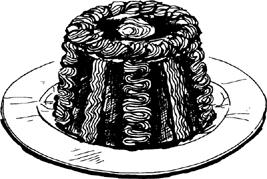Mastering the Art of French Cooking, Volume 2 (181 page)
Read Mastering the Art of French Cooking, Volume 2 Online
Authors: Julia Child

Immediately remove from heat and beat in another cup of the
pralin
to stop the cooking. Then, with electric mixer, beat over ice 5 minutes or so, until thoroughly chilled and mixture forms a thick ribbon when a bit is dropped from beater back onto the surface. Beat in the kirsch or rum, and all the rest of the
pralin
(unless you wish to reserve 2 to 3 tablespoons for decorations); final addition of
pralin
does not melt, because mousse is now cold.
1 cup chilled heavy cream in a 2- to 2½-quart bowl
The electric beater (blades need not be washed)
A rubber spatula
Remove custard mixture from ice, and replace with the cream bowl. Beat cream into
Chantilly
by circulating electric beater about bowl to incorporate as much air as possible; continue beating until cream has doubled in volume and beater leaves light traces on surface of cream. Fold the cream into the chilled custard, and mousse is ready for freezing.
3)
Freezing and serving suggestions
Freezing times at zero degrees or less: 3 hours for individual servings or
parfaits; 6 hours for bowls, molds, and
bombe glacée.
MOUSSE GLACÉE OR PARFAIT
Pile the chilled mousse into a decorative serving bowl or into individual serving dishes or parfait glasses. Cover with plastic wrap and freeze. At serving time, decorate with caramelized walnuts and/or
pralin;
parfaits are usually topped with a swirl of whipped cream before the walnuts or
pralin
goes on. (See note on
frozen swirls at end of recipe.)
SOUFFLÉ GLACÉ
Surround a 4- to 5-cup soufflé dish with a strip of lightly oiled (tasteless salad oil) foil or waxed paper tied or pinned in place, to make a collar that sticks 1½ inches above rim of dish. Pile the chilled mousse into the dish, letting it rise ½ to ¾ inch up the collar; lay plastic wrap over top of collar and freeze the mousse at least 6 hours. Remove collar just before serving, and decorate top of soufflé with caramelized walnuts and/or
pralin.
BOMBE GLACÉE
Follow directions for
bombe glacée à l’abricot
.
Frozen Whipped Cream Swirls
You may form whipped cream swirls, rosettes, or other designs on a plate or baking sheet lined with waxed paper; cover the swirls and freeze them. At serving time, peel them off the paper, and place upon the dessert. For this, the cream must be a little stiffer than the usual
Chantilly
so that it will hold its shape enough to be formed; when stiff enough, fold in confectioner’s sugar and vanilla to taste, pack the cream into a pastry bag or paper decorating cone, and make the designs. (See directions for making
paper decorating cones
.)
LE SAINT-CYR, GLACÉ
[Frozen Chocolate Mousse Molded in Meringues]
Here is a handsome dessert for those happy times when you can indulge in whipped cream and chocolate. It is a mold of frozen chocolate mousse in the
form of a cylinder with ribbons of white meringue marching around the circumference. It will remind you of the tall
képis,
the decorative caps, worn by the officers of Saint-Cyr, the famous French military academy. You can add a visor, edible or not, if you want to complete the picture.
A NOTE ON MERINGUES AND MANUFACTURING METHODS
This dessert is easy to make when you have an electric beater on a stand; if you don’t mind holding on for a while, however, a portable beater is perfectly satisfactory. Rather than being the usual meringue of egg whites beaten to stiff peaks and sugar then folded in, this is the Italian meringue, where boiling sugar syrup is beaten into the stiff egg whites, and the beating continues for 8 to 10 minutes, or until the meringue is cool and forms stiff peaks. It has a double advantage: the meringue shapes bake in half the time of ordinary meringues and the rest of the meringue mixture can be used for the chocolate mousse. Thus you need not bother making a custard base with its attendant beating of sugar and egg yolks over heat; instead, you beat melted chocolate right into the meringue mixture, fold in the whipped cream, and the mousse is made. A further recommendation is that the mousse does not become hard and stiff when frozen; it retains a tender, creamy quality.
For an 8-cup mold, serving 8 to 10 people
1)
The meringue mixture—meringue italienne—1½ quarts
Measure out all the ingredients for this step so that while the sugar is boiling you can finish beating the egg whites.
2 cups sugar
⅔ cup water
A heavy 1½- to 2-quart saucepan with cover
Combine sugar and water in saucepan and set over moderately high heat. Swirl pan slowly by its handle, but do not stir sugar with a spoon while liquid is coming to the boil. Continue swirling for a moment as liquid boils and turns from cloudy to perfectly clear. Cover pan, reduce heat to low, and let simmer slowly while you beat the egg whites.
¾ cup egg whites (6 egg whites) at room temperature
An electric mixer with large (3-quart) clean, dry bowl and blades
Big pinch salt
¼ tsp cream of tartar
½ tsp vanilla extract
Turn egg whites into mixer bowl, and start at slow speed for a minute or so, until egg whites begin to foam up. Beat in the salt and cream of tartar, and gradually increase speed to fast, until egg whites form stiff peaks. (See notes on
beating egg whites
.) Beat in the vanilla.



